Ask any group of mad scientists how they plan to take over the world, and one of the answers that you just might hear is “With giant monsters!” And rightly so. Mucking with the workings of life itselfis one of the key skills in the mad scientist’s arsenal.
Of course, we need to start small. The easiest way to begin is by experimenting on plants. Not only is it much less expensive, but your laboratory will remain more pleasant to work at, since PETP protestors tend to be fewer in number than those from PETA.
Plant growth, in all of its different aspects, is regulated by a complex system of hormones (signal chemicals) that are responsible for phenomena as complex as geotropism and phototropism, rooting and branching, dwarfism, and seed dormancy. It turns out that many of these chemicals are actually used in horticulture and are relatively easy to obtain.
One of the most interesting chemicals to play with is Gibberellic acid, a well-known and easily available plant hormone that can be used to stimulate growth. It is available in liquid form from United Nuclear, and can induce frankly absurdgrowth in many types of plants.
In order to see results quickly, it’s nice to start with a plant that grows quickly. We chose to experiment with mung been sprouts, which ordinarily reach maturity (from a particular salad-eater’s perspective) in about five days.
The technique we are using is based on guidelines from the Institute of Food and Agricultural Sciences, University of Florida. We tested the method prior to experimentation, and found the results to be tasty.
We had assisted with an earlier experiment (shown above) comparing various concentrations of Gibberellic acid where 100 ppm was a clear standout, so we’ll be using 100 ppm for our experimental sample.
For the control sample (marked Kontrol) we soaked one tablespoon of washed and sorted beans in water for twelve to eighteen hours. We then rinsed the beans and poured off the excess water twice a day. For the experimental sample (marked Kaos) we did the initial soak in our 100 ppm Gibberellic acid solution. Twice a day we rinsed, first in water which was drained off, then in the Gibberellic acid solution, pouring off the excess. Both jars were capped with cheesecloth and stored in a dark cabinet when not being rinsed or photographed.
After a day, there isn’t much visible difference between the groups. It looks like fewer of the control group (on the left) are showing signs of sprouting, which isn’t surprising, as Gibberellic acid improves germination.
On day three, there are more and longer sprouts in the experimental group (on the right).
By day four, the volume of the control group is only half that of the experimental group.
On day five, the experimental sprouts are definitely trying to escape. Sprouts are normally eaten on the fourth or fifth day, but we don’t recommend eating the sprouts treated with Gibberellic acid (see MSDS).
From here, it’s only a hop skip and a jump to making your very own giant monster. (Which is good bonus points if you live in New York or Japan.)





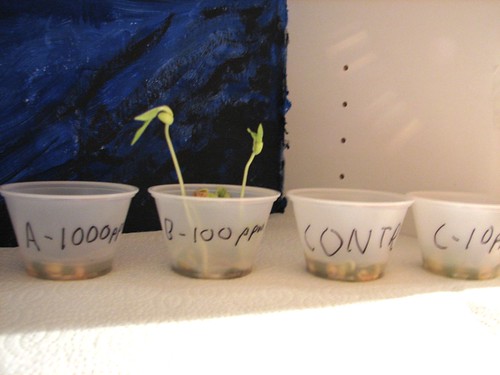
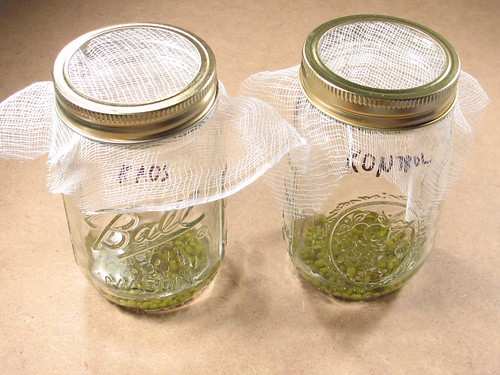
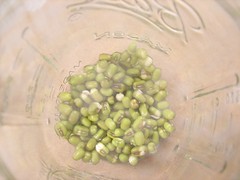

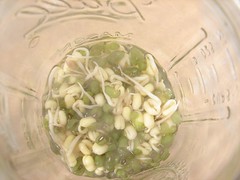
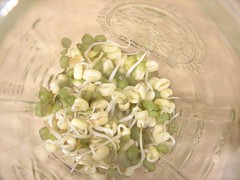
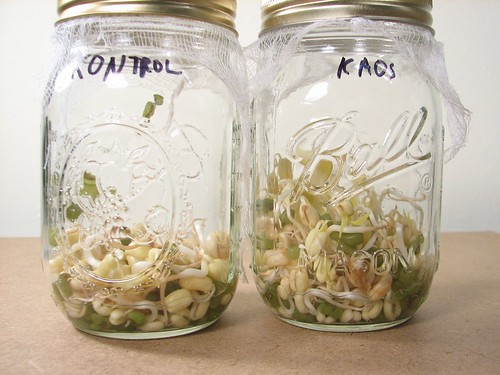
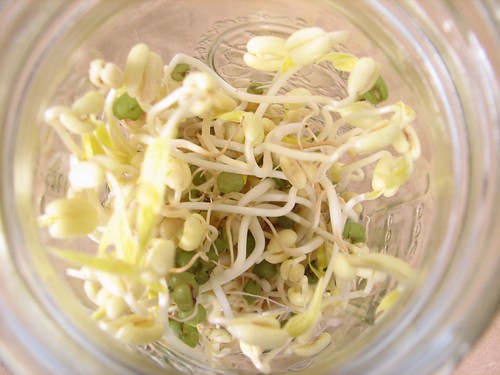
bonus points for referencing another evil organization bent on world domination. (KAOS)
I will henceforth name all my experiment groups Kaos and Kontrol :-D
It’s about time we get some cool science stuff again! (Too much clothwork to be honest). I may have to try get working on my super-sized pitcher plant now… ;)
Oooh! I get it
Control vs Kaos
"Get SMART" !!
now is the time to make trifids run
I need to jump-start some hybrid hugantic sized pumpkins for Halloween. I wonder if this will help.
This hormone primarily affects germination and stem growth. How it affects fruits depends on the type of fruit and when and how often it’s applied. Doubtless, starting with a larger pumpkin variety is more important!
—
Windell H. Oskay
drwho(at)evilmadscientist.com
http://www.evilmadscientist.com/
Makes one wonder if this works with hemp. Guess I’ll have to try.
took a look at the MSDS sheet … what’s wrong with eating the sprouts (or other plants) if the acid is thoroughly rinsed away before consumption?
Does the acid have to be applied continually through the growth cycle to maintain these kinds of results? (eg for plants that take more than 5 days to grow, do they need to continually be bathed in this to grow large? And is it only the roots and stem that need to be soaked with the acidic solution or the whole plant (leaves, budding flower/fruit, etc)?
Yes, these *should* be safe if you rinse them thoroughly. However, it’s easily possible to experiment with high concentrations, and schoolkids may try this experiment, so it’s better for us to make the large print err on the side of caution.
As for the rest, these are good questions, and we don’t really have the answers. Gibberellic acid is primarily responsible for stem growth in this context, although it also has different effects on rooting and fruiting, and is both topically and generally applied to different plants, for different purposes.
—
Windell H. Oskay
drwho(at)evilmadscientist.com
http://www.evilmadscientist.com/
Is this really gigantism or simply accelerated growth? It would be interesting to try it with a plant that quickly grows to a maximum size, perhaps next year I will try it with something usually manageable like a chili and see whether I get monster plants (and/or fruit.)
It certainly appears to be giantism as opposed to accelerated growth; the maximum stem length that you see in the sprouts– before leaves appear– is *very* large compared to what you normally see.
This chemical affects *stem growth*, and has different effects on different plants at different stages. YMMV.
—
Windell H. Oskay
drwho(at)evilmadscientist.com
http://www.evilmadscientist.com/
But wouldn’t stem length indicate accelerated growth?
While stem girth and leaf size indicate giantism?
Any updates?
i have used GA3 myself and i can tell u it is neither.
the truth is that this chemical is the same chemical that is released by the plants
upon sprouting.
what it does is trigger the sprouting process so that other seeds in the vicinity will
sprout at the same time.
essentially its a germination accelerator.
an old trick that works well is to sew some peas along with the seeds u want to grow.
peas produce the same chemical in the right proportions etc, so that your seed will
get some extra incentive to sprout.
once they do, just cut off the pea plants.
It *is* also used as a germination accelerator, but that’s not the whole story– not by a mile.
Windell H. Oskay
drwho(at)evilmadscientist.com
http://www.evilmadscientist.com/
Obviously, depends what you mean by "giantism" and "accelerated growth." This is a matter of semantics, not biology. If a human grew to twice normal height in the normal number of years, you could be equally accurate in describing it as either accelerated growth or giantism, depending on your definitions.
—
Windell H. Oskay
drwho(at)evilmadscientist.com
http://www.evilmadscientist.com/